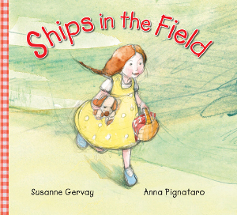Ships in the field by Suzanne Gervay

Ill. by Anna Pignataro. Ford St
Publishing, 2011. ISBN 978192665233.
(Ages: 6+) Picture book. Migration.
The girl hugs her toy dog, Brownie, as her father twirls them around
after coming home from work. Mum watches on rather sadly, but
significantly and unusually kisses the little girl on the top of her
head. Both parents have come from another country, one destroyed by
war, a memory which still haunts the mother. Each parent works at a
manual job even though they had better professions in their old
country. The little girl longs for a dog. Quietly, the author ties
in
subtle clues showing what this family has lost in coming to
Australia,
and when going on a picnic, reveals some of the small slights they
endure in settling into a new place, exemplified by the title, the
meaning of which becomes clear in the last few pages. A subtle
story,
overlaid with beautiful water colour images of Australia after World
War 2, the small girl and her family stand for the many hundreds of
thousands of refugees, displaced people, migrants and asylum seekers
who came to our shores at that terrible time in world history. The
gentleness of the water colour images belie the nature of war which
displaced this family, but closer inspection of these pages reveals
the
horror and destruction which occurred.
A reminder from the author and illustrator of the nature of
Australia's
population, Gervay and Pignataro are both children of people who
found
a safe haven in Australia. This book is a complimentary addition to
the
library and classroom where books such as The littlest refugee
(Ahn Do) and Ziba came on a boat (Liz Lofthouse) are
available.
With Ships in the field talking about post World War 2, The
littlest
refugee evoking memories of the boat people after the end
of the Vietnam War and Ziba came on a boat revealing what it
is
like now for people searching for asylum in Australia, any reader
will
gain further understanding and sympathy for the refugee's flight.
Fran Knight